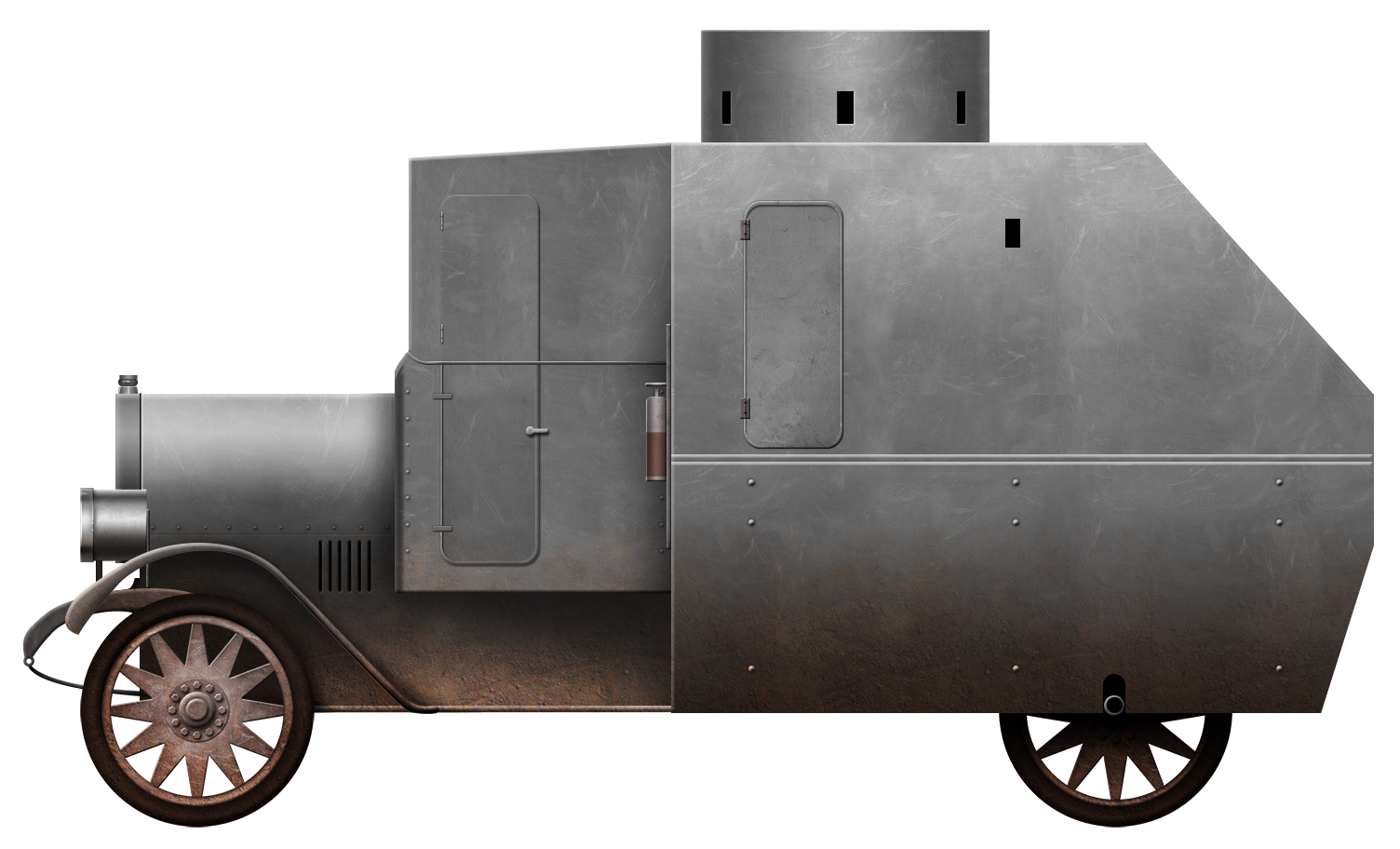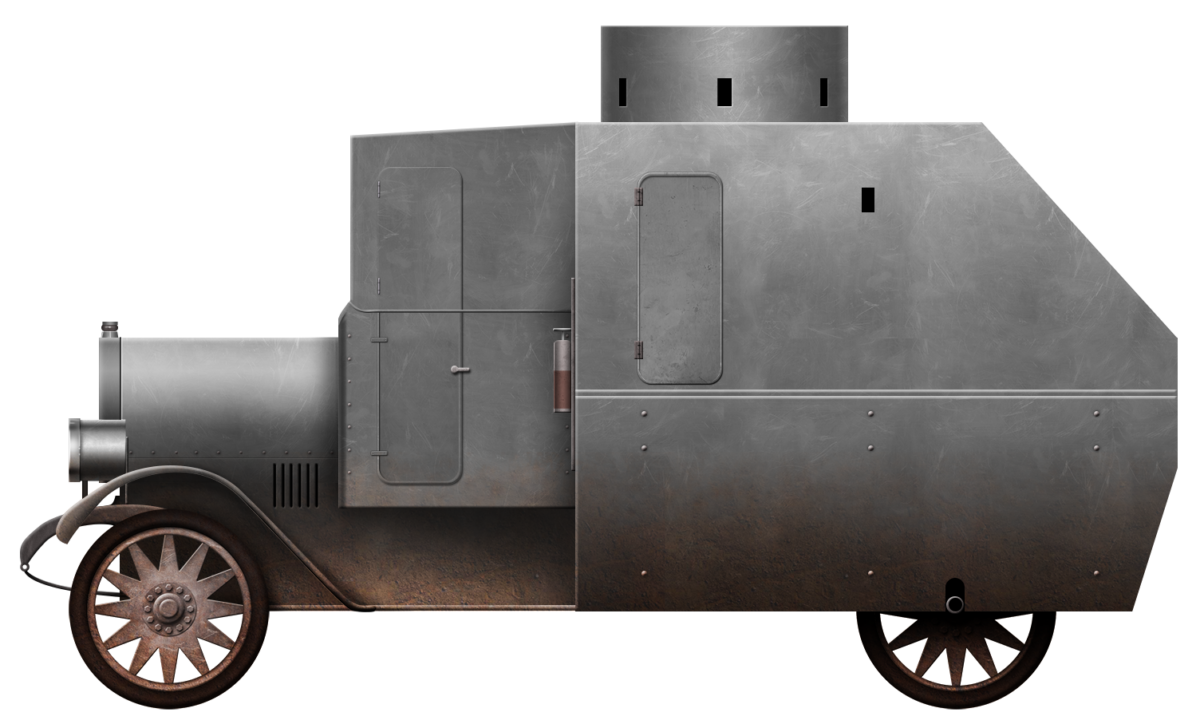 Kingdom of Denmark (1917)
Kingdom of Denmark (1917)
Armored Car – 1 Mock-up Built
Already before the start of World War I, most larger armies in Europe were introduced to the armored car in one way or another. During the war, armored cars were also quickly deployed on the battlefields in increasing numbers, making it a regular piece of equipment. However, for the Kingdom of Denmark, things were a bit different. Fielding only a small army, and avoiding involvement in the war, the concept of the armored car was not physically introduced. The military, however, were not oblivious of their existence and a commission was set up in 1915 to study the armored concept. In early 1917, this led to the creation of a truck equipped with plywood to resemble armor.

Developments in Denmark
Modest motorization of the Danish Army began in 1908 when the first truck was purchased. The truck in question was a FIAT 18/24 hp which had been selected after evaluation of several brands. During the next year, the Army Technical Corps (Danish: Hærens tekniske Korps, shortened to HtK) was established. This unit became, among other things, responsible for the acquisition of new weaponry, including vehicles.
The first design office of the HtK was established in 1915. Captain C.H. Rye was placed in command of this new office. From 1902, he had served with the technical services of the artillery and, since 1909, with the HtK. The new office was tasked with developing the concept of an armored car for the Army. To get acquainted with the aspects and problems of motorization and armoring, Captain Rye was dispatched to Germany for four weeks to study their approach. Based on his findings, the design office started developing a variety of concepts, but none were able to be implemented.

That would change in early 1917. In 1916, the Army had ordered several trucks from the company Rud. Kramper & Jørgensen A/S, which produced vehicles under the name ‘Gideon’. With the modest funds available, one of the 2-tonne trucks, with registration number HtK 114, was experimentally equipped with plywood resembling a proposed armor layout. Work was carried out during the spring of 1917 and subsequent trials proved the concept was successful. The HtK expressed the desire to continue the production of a real armored car. On 4th February 1918, HtK sent a letter to the War Ministry requesting continuation of the project and funds to construct an actual armored vehicle. Shortly thereafter, on 8th February, Mr. Munch, the Minister of War, responded negatively. He stated that it was not in the vision of the Ministry to buy an armored car, due to a lack of available funds.
Thus, the project that could have produced the first armored car of Denmark was canceled completely. The plywood was removed and the truck was rebuilt as a maintenance vehicle in 1918, to be used by the Army Aviation School (Danish: Hærens Flyvenskole). It was rebuilt yet again in 1920 and, at that time, also received HtK 14 as a new registration. Sometime in 1922 or 1923, it was disposed of and scrapped, finally ending the life of a truck that could have been Denmark’s first armored car.
The honor of being the nation’s first armored car was, instead, reserved for a vehicle built as a private initiative in the summer of 1917. This vehicle was based on a French Hotchkiss car and received the registration HtK 46 and is therefore known as the Hotchkiss Htk 46. This vehicle was based on a different design philosophy compared to the Gideon truck. Whereas the Gideon truck slightly resembled the German approach to armored car building, with a big superstructure and a fixed, round turret on the roof, the Hotchkiss took the Allied approach, with a smaller size, and open-topped construction, also seen with French and Belgian armored cars.

Design
The German influence is visible in the design, most notably in the fixed round turret on the roof with gunports facing in several directions. The original design of the flatbed truck was largely left intact but with the open driver’s cab and open flatbed fully enclosed in a plywood body. In front of the driver was one large opening for vision. The original cabin doors were retained, and a further door was added in the rear superstructure. The engine bay and the lower portion of the driver’s cabin were not covered in plywood, but if an actual armored body was to be built, these parts would likely have been armored as well. A driver in the cabin, a commander in the turret, and possibly up to two gunners would have crewed the vehicle.
One gunport was placed in the front and one on each side. It is unknown if any gunports were made in the rear since the single known photograph only shows the front and left side of the vehicle. If the armored version had been built, it would have been armed with several machine guns. In comparison, the Hotchkiss HtK 46 was equipped with two Madsen 8×58 mm machine guns. A Gideon 4-cylinder petrol engine, producing 14.8 hp, powered the truck.

Rud. Kramper & Jørgensen A/S
In light of the relative obscurity of the vehicle, it is also worthwhile to mention the manufacturer of the truck that was used. In 1891, Rudolf Kramper founded a company that started to produce agricultural machines. Besides this venture, he designed and started to build so-called Gideon engines in 1893. This production expanded and production commenced of several types of engines, with different purposes and different types of fuel consumptions. However, due to financial difficulties, Kramper had to file bankruptcy in 1901. This led to the formation of a partnership with Sofus Jørgensen and the company was re-established as Rud. Kramper & Jørgensen A/S.
From 1913 onwards, the firm also started to build vehicles under the name Gideon, after the name of the engines already in production. Before the firm had to file bankruptcy again, in 1920, it had produced up to 160 or possibly even 184 vehicles. No other Danish vehicle manufacturer reached those production numbers.

Conclusion
Glancing over the single photograph, one may think the Gideon was of improvised construction, but in fact, it was the result of over a year of study and conceptualization. Naturally, plywood is much lighter than actual armor plating so whether a real armored vehicle would have performed as satisfactorily remains speculation, although the increase of weight was likely taken into account during the trials. Like many other armored vehicle concepts, it was eventually killed due to a lack of funds. Although the Gideon can take the place as the first armored car project in the Kingdom of Denmark, the first armored car became the Hotchkiss HtK 46, which was privately funded.

Specifications
|
|
| Crew | 4 (Commander, Driver, several Gunners) |
| Propulsion | Gideon 4-cylinder petrol, 14.8 hp (11 kW) |
| Armament | at least one machine gun |
| Armor | plywood simulating armor, proposed thickness unknown |
Sources
Gideon 2 T Truck, armyvehicles.dk.
Gideon 2 T, 1917, armyvehicles.dk.
Charles Henry Rye, by Povl Gain, Danish Biographical Encyclopedia.
Luksusbil fra Horsens, Horsens Folkeblad, 14 May 1994, PDF.
Pancerni wikingowie – broń pancerna w armii duńskiej 1918-1940, Polygon Magazin, 6/2011.
Rud. Kramper & Jørgensen A/S, horsensbilleder.dk.

